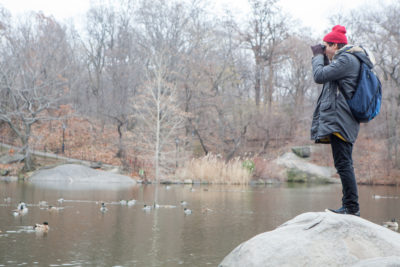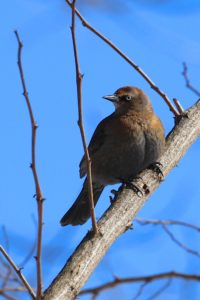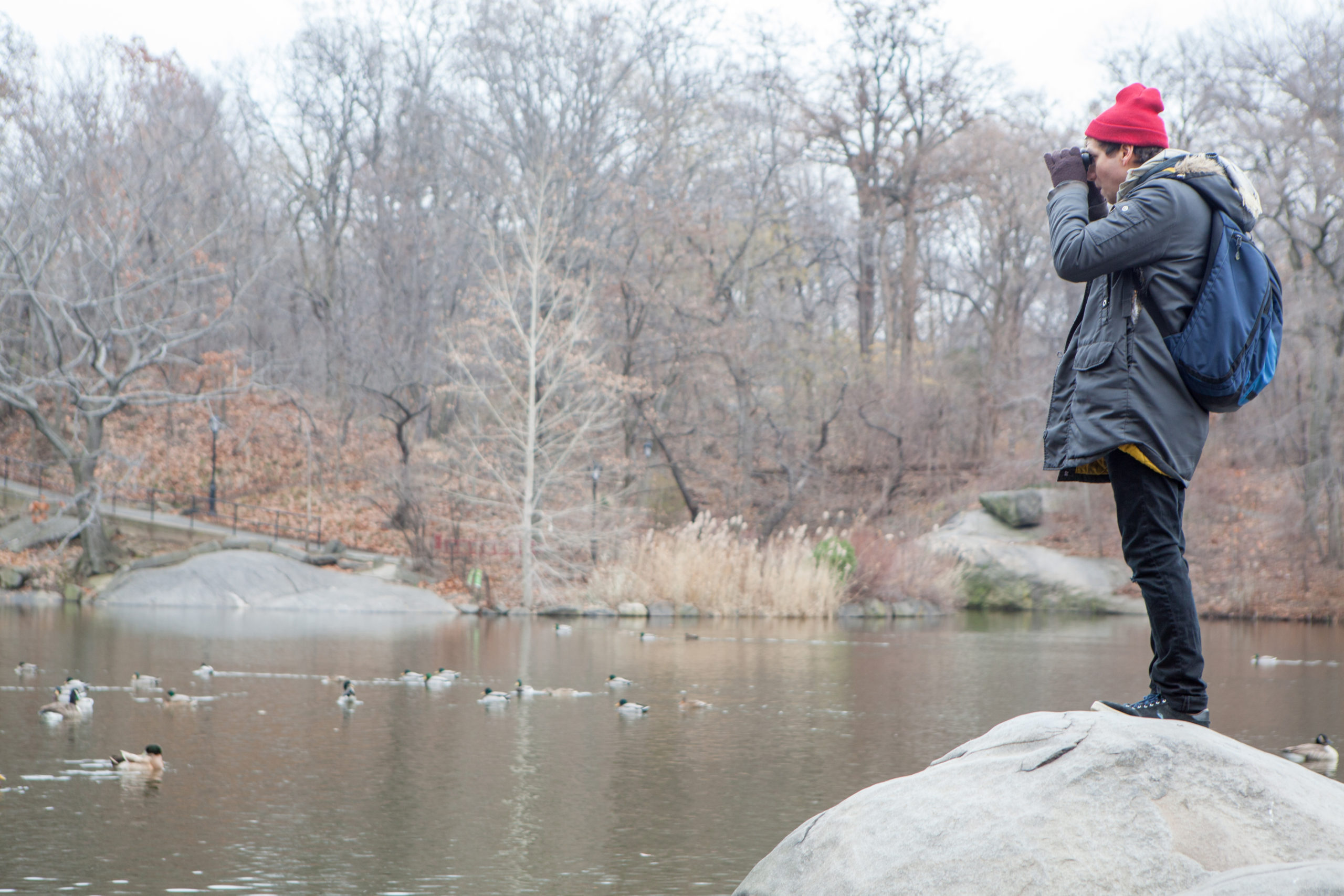This article originally appeared in the 2020 Winter Jack Pine Warbler. Please see Michigan Audubon’s position on birding-related travel decisions following this piece.
Five-Mile Radius Birding: Keeping it close to home
by Kirby Adams
How many species of birds can be found throughout the year within five miles of your front door? Folks in Michigan who aren’t regularly immersed in nature might guess only a couple dozen. Even those with naturalist tendencies might presume 50 or 60 would be a good number. I live in an area of lots of bean fields and low bird diversity in Eaton County, but over the past five years, I’ve tallied 164 bird species within a 5-mile radius centered on my house. I know that number because I’ve become a dedicated 5MR (5-mile radius) birder.

Photo by Camilla Cerea (Christmas Bird Count 2014)
As with most new trends, 5MR birding seems to have either originated or first gained popularity in California. For a variety of reasons, not the least of which is the excuse for one more list, birders started looking at how many birds could be found not just in the yard, but within 5 miles of home. Competition led to people seeking out unknown birdy spots near their homes, and now we have a new aspect of the hobby that’s fun, easy, inexpensive, and can be a great asset to conservation.
Birding in Peru or Florida is expensive. Even birding on Michigan’s Lake Erie shore can be time-consuming and costly when you live in Ironwood. But 5MR birding lets you work on a list all year without much cost. It can also be done by many people without consuming any fossil fuels, always a bonus for the environmentally-conscious birder. The exercise of biking or walking to cover those 78 square miles in your 5MR might make you a healthier birder too!
The 5MR birding style forces you to not just go to a popular hotspot like Pointe Mouillee or Whitefish Point, but to find good fragments of habitat that would otherwise be overlooked by birders. In farm country, hedgerows and drainages are worth checking out regularly in spring and summer. You’ll learn the location of every berry-bearing tree anywhere near your home in short order if you’re trying to boost your 5MR list in winter. You’ll find previously unknown patches of oak in spring and black walnut in the fall, looking for those last few warblers you need. You’ll discover that a remarkably small pond can host diving ducks when you’re desperate for a Canvasback in your 5MR before freeze-out next December. When you look at these otherwise unmonitored habitats day after day, you begin to see trends. If you share your data to eBird, those trends can inform population studies and conservation efforts.
Habitat conservation isn’t just about fighting climate change and protecting huge swaths of pristine habitat. Exploring your 5MR will show you that a hedgerow between two farm plots can be a conservation success story when it’s filled with native plants and not subjected to irresponsible use of pesticides. That little strip of land half a mile long and 20 feet wide is an oasis of refuge for pollinators and other insects, which in turn bring the birds. This can be particularly critical during migration. When the sun rises and a small flock of warblers is exhausted and near expiration, a vast expanse of lifeless farm field with no food or cover is a death sentence. The thin strip of multi-hued greens marking the ditch between two fields is a literal life-saver. If you’re spending every day in May at a migrant trap on the lakeshores, you might never notice it, but most of the migrants on my 5MR list have come from walking or biking country roads and lingering at every hedgerow.

Rusty Blackbird by Linette Mansberger (Audubon GBBC 2016)
Making an effort to monitor spots closer to home can also be a part of a more specific conservation effort. Since 2005, the International Rusty Blackbird Working Group (IRBWG) has been working to identify and hopefully mitigate the causes of a greater than 90 percent reduction in the Rusty Blackbird population. Identification of migration stopover habitat is a large part of that research and included several years of a “Rusty Blackbird Blitz” utilizing eBird. I happened to stumble onto a spot less than a mile from my home that has proven to be a regular location for Rusty Blackbirds in each of the last four Aprils and three of the corresponding falls. I discovered this by walking a road to see if I could boost my 5MR numbers. I drive past the spot on the way to work every day, but the blackbirds are typically deep in a tangled expanse of dogwoods in a seasonally flooded section of a small woodlot. I’d never notice them without walking past and first hearing their distinctive call. 5MR birding led directly to the identification of a spot that hosts hundreds of Rusty Blackbirds every year. Now the IRBWG has those data via eBird, and even if that spot can’t get dedicated habitat preservation from a large NGO, you can bet I’ll be making a few calls if that corner lot ever comes up for sale.
Competitive birding and list-building are often maligned by birders who are dedicated to conservation, but I’d encourage folks to give 5MR birding a try, even if you never mention the number to anyone. If the 5-mile radius just misses the best park in the county, you can always cheat a little, or be true to the 5MR spirit and find somewhere that’s just as good as that park but has never had binoculars pointed at it. You make the rules and you have the fun, but either way, the birds win. And if you want to be competitive, I’m betting almost everyone in Michigan could beat my 164 5MR with a little work.
— — — — —
Kirby Adams ([email protected]) writes the birding column for the online travel blog, National Parks Traveler. Kirby lives in Eaton Rapids.
Click here to download a pdf of this article.
A note from Michigan Audubon ~
Maneuvering the ever-changing implications of COVID-19 has necessitated constant adaptation and evaluation for us all. While Michigan Audubon continues to keep our sanctuaries and Whitefish Point Bird Observatory open, we hope you will take a cue from Kirby Adams and keep your birding close to home.
It is important to remember that no two communities have been affected by COVID-19 in the same way — some have few positive coronavirus cases reported, and some do not have the infrastructure to handle a large number of sick people. By limiting your travel, you are playing a vital role in keeping people safe and ensuring that we can make a swifter recovery from this virus.
If tempted to travel to experience the joys of spring migration or perhaps to add to your life list, please take a moment to read American Birding Association’s recent guidelines on birding and social distancing, a useful resource for guiding bird-related travel decisions. We at Michigan Audubon agree with their cheeky position that it is best to “Keep your eyes on the sky and your butt close to home!”

